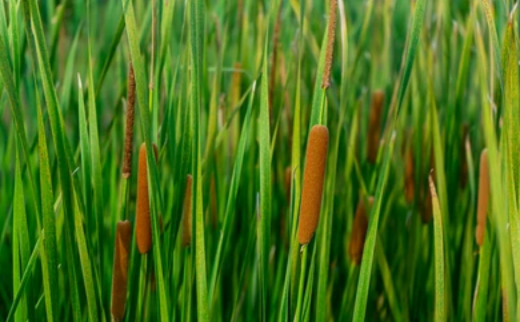Typha angustata Bory & Chaub. / Gundra / Eraka / Gond Patera / Typha elephantina Roxb.
Abstract
Typha angustata, commonly known as Narrow-leaved Cattail, is a perennial aquatic plant traditionally used in Ayurveda and folk medicine. It is found abundantly in wetlands, marshes and the banks of lakes and rivers. It holds therapeutic value for its anti-inflammatory, astringent and wound-healing properties. The plant, particularly its pollen and rhizome, is incorporated in remedies for bleeding disorders, wounds and urinary conditions. Its use extends to managing digestive issues and supporting postnatal recovery. Rich in bioactive compounds, Typha angustata represents a valuable but underutilised medicinal plant in holistic healing practices.

Introduction
Typha angustata is a perennial aquatic plant commonly found in waterlogged regions and classified under the family Typhaceae. It is widely recognised for its medicinal value and is mentioned in several traditional medical texts from India, China and Turkey. This aquatic weed is well known for its diverse therapeutic applications across various traditional healing systems. Typha is a genus that includes the species Typha angustata and comprises around eleven species of monocotyledonous flowering plants belonging to the family Typhaceae. While the genus is predominantly found in the Northern Hemisphere, it has an essentially cosmopolitan distribution, occurring in various regions across the globe. With growing interest in plant-based medicine, Typha angustata is now being revisited for its potential pharmacological benefits and ecological adaptability.
Scientific Classification
- Kingdom: Plantae
- Subkingdom: Tracheobionta
- Division: Magnoliophyta
- Class: Liliopsida
- Order: Poales
- Family: Typhaceae
- Genus: Typha
- Species: Typha angustata Bory & Chaub.
Synonyms
- Gundra
- Pateraka
- Gulma
- Sringaverabhamulaka
Vernacular Names
- Hindi Name – Pater, Gound pater
- Marathi Name – Ramaban, Pun, Pan kanis
- English Name – Lesser Indian Reed mace, Elephant Grass, Small bulrush, cattails
- Kannada Name – Apu
- Tamil Name – Sambu
- Telugu Name – Dabbu Jammu, jammu, jambu
- Bengali Name – Kaaba, hogla
- Chinese Name – Chang bao xiang Pu
- Japanese Name – Hime-gama
Habitat
Cattails are typically found in or around water bodies such as marshes, ponds, lakes, and low-lying wet areas. They are classified as obligate wetland indicator species, meaning they thrive in saturated environments. These plants can withstand prolonged flooding, low-oxygen soil conditions, and moderate levels of salinity. Given an abundance of nutrients or freshwater, cattails can become highly invasive in both brackish and freshwater wetlands. Narrow-leaved cattails, in particular, are commonly found in marshes below 2000 meters elevation and are widely distributed across North America and Eurasia.
Morphology
Typha angustata is a perennial aquatic plant that typically grows to a height of 1.5 to 2 meters. It is commonly found along riverbanks and in ponds. The leaves are slender, measuring 5 to 12 mm in thickness, and both the stem and leaves grow upright. Male and female flowers are borne on the same vertical stem in dense, cylindrical spikes. The seeds are tiny, approximately 0.2 mm long, and are attached to fine hairs or stalks, aiding in their dispersal.
Varieties
There is another variety of herb which has the same family but a different species. Its Latin name is Typha elephantina Roxb. and it is also known as Elephant grass and Eraka.
Eraka
It is mostly found in the swamps of north-western India, Assam and southwards and in the Indus delta. This grassy vegetation that grows in swamps is 2 to 4 m long and grows in groups. Leaves are root-like, 10–15 cm long, 18 mm to 3 cm wide and concave. Their edge is wavy towards the front. Flowers: The umbellate clusters of female flowers are 20–50 cm long and brownish orange in colour. From these same clusters, clusters of male flowers 20–55 cm long also emerge. Its other species, Typha angustata, is also found. The main difference between them is in the leaves of both. In the first species, the leaf circle above the cotyledonous leaf base is triangular and in the second species, it is sometimes circular. Mats are made from their leaves.
Properties And Uses
It is cooling, diuretic, absorbent, semen enhancer, eye-opener and stone-killer, burn and hematemesis. By crushing its flowers and tying them on the wound, the wound heals quickly.
Classical Categorisation
- According to Bhavaprakasha Nighantu – Guduchyadi Varga
- According to Charaka Samhitha – Stanya jana varga (lactation-promoting herbs)
- According to Kaiyadeva Nighantu – Aushadi Varga
- According to Dhanvantari Nighantu – Karaviradi Varga
Ancient Verses
Verse 1
गुन्द्रः कषायो मधुरः शिशिरः पित्तरक्तजित् ।
स्तन्यशुक्ररजोमूत्रशोधनो मूत्रकृच्छ्रहृत् ।।
(Bhavprakash Nighantu Guduchyadi varga 163)
According to this shloka, Gundra has a sweet and astringent taste, cold potency and it is effective in the management of bleeding disorders and dysuria. It helps in the purification of breast milk, urine and seminal fluid.
Verse 2
एरका शिशिरा वृष्या चक्षुष्या वातकोपिनी ।
मूत्रकृच्छाश्मरीदाहपित्तशोणितनाशिनी ।।
(Bhavprakash Nighantu Guduchyadi varga 164)
According to the above shloka, Eraka has cold potency and aphrodisiac properties. It is effective in the management of dysuria, stones, burning sensation, bleeding and eye disorders.
Ayurvedic Properties
- Taste (Rasa): Sweet (Madhur), Astringent (Kashaya)
- Potency (Veerya): Cold Potency (Sheet)
- Effect on Tridosha: Balances Pitta dosha
Therapeutic Properties
- Nosebleeds (Epistaxis)
- Hematemesis (Vomiting of blood)
- Hematuria (Blood in urine)
- Uterine bleeding / Menorrhagia
- Dysmenorrhea (Painful menstruation)
- Postpartum abdominal pain
- Gastralgia (Stomach pain)
- Scrofula (Tuberculous lymphadenitis)
- Abscesses
- Oedema (as a diuretic)
- Inflammatory conditions (as an anti-inflammatory agent)
- Alzheimer’s disease (due to antioxidants)
- Vascular disorders (e.g., vascular smooth muscle proliferation)
- Dental and bone regeneration issues (due to osteoinductive support)
- Fluoride toxicity / Water purification (via activated carbon)
Systemic Actions
External Uses
- Its leaves are effective in the management of wounds on external application.
Internal Uses
- Urinary System: Effective in the management of stones and dysuria due to its diuretic properties.
- Circulatory System: Widely used in the management of bleeding disorders.
Chemical Composition
Flavonoids
- Naringenin
- Isorhamnetin
- Quercetin
- Isorhamnetin-3-O-(2-α-L-rhamnopyranosyl)-rutinoside
- Quercetin-3-O-(2-α-L-rhamnopyranosyl)-rutinoside
- Isorhamnetin-3-O-rutinoside
- Isorhamnetin-3-O-neohesperidoside
- Kaempferol-3-O-neohesperidoside
Sterols
- β-Sitosterol
- Lanosterol
- Cholesterol
Polysaccharides
- Present in roots
Fatty Acids
- α-Linolenic acid
- Linoleic acid
- Unidentified C82 fatty acid
Crystalline Compounds From Inflorescence
- Vanillic acid
- p-Hydroxycinnamic acid
- Protocatechuic acid
- E-Propenoic acid-3-(hydroxyphenyl)-2,3-dihydroxypropyl ester
- Succinic acid
- p-Hydroxybenzaldehyde
- D-Mannitol
Other Constituents
- Carbohydrates
- Glycosides
- Phenolics
Practical Uses
Uses Of Typha Angustata
- Stems and leaves are used in paper production.
- They can be woven into items such as mats, chairs, and hats.
- Widely utilised as biomass, fibre, thatching, and for weaving purposes.
- It possesses excellent insulating properties.
- Contribute to soil stabilisation along riverbanks and lake shores.
- Fruit hairs are used as stuffing material for pillows.
Uses Of Typha Elephantina Roxb.
- A paste made from Typha elephantina flowers is applied to wounds.
- The soft, woolly floss of male spikes and down from ripe fruits is used as medicated absorbents for wounds and ulcers.
Part Used
- Leaves
- Pollen
- Stems
- Seeds
- Roots
Dosage
- Powder: 3–6 gms
Conclusion
Typha angustata, commonly known as narrow-leaved cattail, emerges as a highly adaptable and widespread species. Its robust growth, often forming dense stands, underscores its significant ecological role in wetland ecosystems, contributing to habitat structure and primary productivity. However, this very success can also pose challenges, as its aggressive colonisation may lead to reduced biodiversity in certain areas. Understanding its ecological dynamics and reproductive strategies is crucial for effective wetland management and for harnessing its potential in bioremediation while mitigating its invasive tendencies where necessary.



